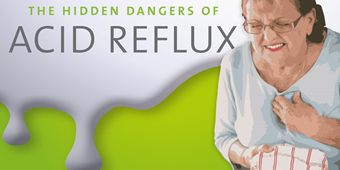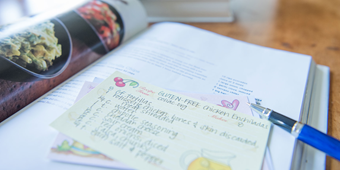Gut Reaction: Understanding Gallstones

Answer a few questions and we'll provide you with a list of primary care providers that best fit your needs.
One in 10 Americans will have a gallstone – maybe more. The good news is that if you’re in the unlucky 10 percent, you likely won’t know you have a gallstone. Eighty percent of people with gallstones never have symptoms.
The stones can range in size from a speck of sand to a golf ball. Sometimes bigger stones interfere with digestive functions. And a gallstone that blocks passage of the digestive fluid bile from the gallbladder to the small intestine can cause you pain and infection.
Who Is Likely to Develop Gallstones?
You have a higher chance of developing gallstones if you are a woman and over age 60. Others at higher risk include:
- Women who are pregnant or have a history of multiple pregnancies
- People with a family history of gallstones
- Individuals of Hispanic or American Indian heritage
- Those who are overweight, obese or eat a high-fat diet
- People who have diabetes
- Women who take birth control pills
- People who have rapidly lost weight
Understanding the Work of the Gallbladder
The gallbladder looks like a small water balloon tucked beneath the liver, explains Steven Sutherin, MD, FACS, a general surgeon with Miami Valley Surgery Associates.
The organ stores bile, the fluid made by the liver to help digest food, primarily fats. Sometimes the bile crystallizes, like sugar candy, into a hard gallstone. When the gallbladder goes into action after you eat a meal, it squeezes down to push the bile out through the bile ducts and to the small intestine to aid digestion.
Sometimes a gallstone blocks the opening out of the gallbladder or gets stuck somewhere in the bile duct that carries bile to the small intestine.
When bile backs up, you experience a gallbladder attack.
Eighty percent of people with gallstones never have symptoms.
What a Gallbladder Attack Feels Like
As your gallbladder squeezes harder and harder to empty itself, and the bile has nowhere to go, you’ll initially feel like you have indigestion.
“It’s like you may have eaten a bad meal,” says Dr. Sutherin. He explains that the attack starts in the center of the belly and moves to the right, upper abdomen. Sometimes it moves to the shoulder blades in the back.
“Some patients will get a little bit of nausea,” he continues. “As long as there’s food in the stomach and it’s stimulating the gallbladder, the attack will last anywhere from one to four hours and sometimes up to six hours.”
If the attack continues past eight hours, most people go to the emergency room to seek relief, he notes.
Dr. Sutherin says the attacks can be worse if you’ve eaten high-fat foods like pizza or fried chicken, because the fats in the stomach make the gallbladder work harder.
Diagnosing Gallstones

There’s no need to diagnose gallstones unless they are causing you discomfort. If you have symptoms, your doctor will recommend the most effective test for your situation.
The simplest test is an abdominal ultrasound, which uses sound waves to create images of your gallbladder and stones, if any are present. Because this test doesn’t use X-rays, it’s safe for everyone, including women who are pregnant.
An abdominal CT scan uses X-rays to create detailed images of the abdomen, including gallstones and problems with the gallbladder or bile ducts.
A HIDA scan (cholescintigraphy) is an imaging study that checks your gallbladder and your bile ducts. A small, safe amount of radioactive material is injected into your vein and travels to your liver and gallbladder. The doctor uses a special scanner to visualize how effectively your gallbladder is contracting or whether you have a blockage in your bile duct.
An MRCP (magnetic resonance cholangiopancreatography) is an MRI scan that identifies gallstones and can show inflammation or blockage in the gallbladder or bile duct.
A gallstone that moves into the bile duct and becomes infected can cause pain, fever and yellowing of the eyes and skin. A test called ERCP (endoscopic retrograde cholangiopancreatogram) uses X-rays and a lighted tube that goes down your throat and into your stomach and upper small intestine. By squirting dye through the tube into your bile ducts, your doctor can study X-ray images of the ducts to detect problems. This procedure can even remove gallstones and avoid an immediate need for surgery.
Treating Gallstones
“Once we have the diagnosis of gallstone disease or gallbladder problems, we have a couple treatment options,” Dr. Sutherin says.
“One is simple lifestyle alteration: avoid the foods that cause the attacks. Stay on a low-fat diet. There are medications that can be given in a select few patients that might dissolve the gallstones. They are not necessarily very effective, but in a patient who is too high risk to undergo surgery or any other treatments, that might be a treatment option. Then the third option, which really is the gold standard of all gallbladder disease, is surgery.”
Dr. Sutherin explains that removing the gallbladder eliminates the highly likely possibility of new gallstones forming.
“If we went in and took just the gallstones out and left the gallbladder, those patients will usually get their gallstones back within one to two years, and we'd have to operate on them again,” he says.
Laparoscopic surgery with just two to four small incisions “gets rid of the gallbladder and gets rid of the gallstones,” he says. “It's one of the safest operations done in the United States.”
Following gallbladder surgery you may have to avoid greasy or high-fat foods for a while as your body adjusts to not having a gallbladder.
Answer a few questions and we'll provide you with a list of primary care providers that best fit your needs.
Source: Steven Sutherin, MD, FACS, Miami Valley Surgery Associates; National Institutes of Health; American College of Gastroenterology; Radiologyinfo.org




